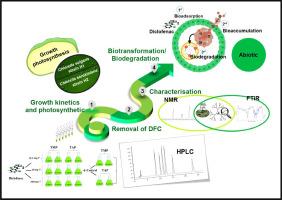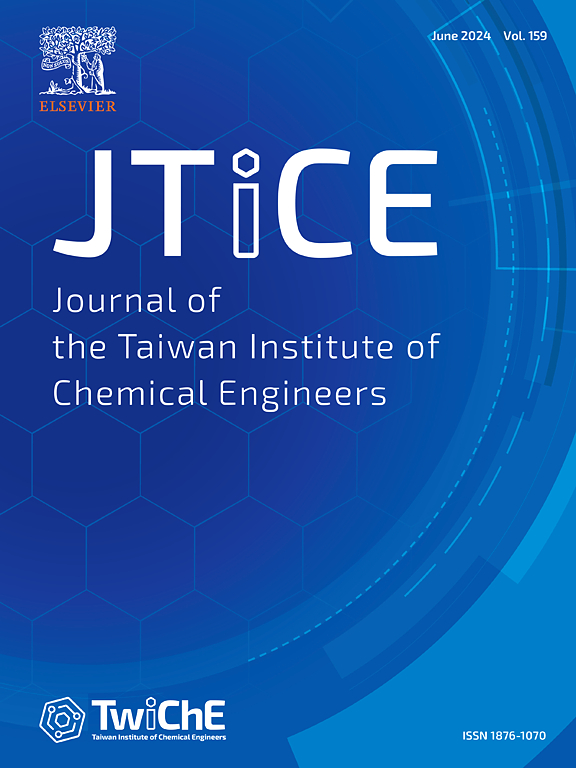Maximizing diclofenac bioremoval efficiency using Chlorella vulgaris strain H1 and Chlorella sorokiniana strain H2: Unveiling the impact of acetic acid on microalgae
IF 5.5
3区 工程技术
Q1 ENGINEERING, CHEMICAL
Journal of the Taiwan Institute of Chemical Engineers
Pub Date : 2024-09-27
DOI:10.1016/j.jtice.2024.105783
引用次数: 0
Abstract
Background
Diclofenac (DFC) is a commonly detected pharmaceutical pollutant in wastewater, posing environmental risks. Microalgae have emerged as potential candidates for bioremediation due to their ability to degrade pollutants. This study focuses on investigating the biodegradation potential of two newly isolated microalgae strains, Chlorella vulgaris strain H1 and Chlorella sorokiniana strain H2, towards DFC removal. The optimization of pH is crucial for enhancing the efficiency of bioremediation processes. Therefore, in addition to assessing the biodegradation potential of microalgae, this study also investigates the impact of adjusting the pH of the culture medium using acetic acid as an additional carbon source on the biodegradation process.
Methods
Through genetic analysis using 18S rDNA sequencing, the microalgae strains were identified. Various parameters including growth dynamics, chlorophyll content, cell proliferation, photosynthetic activity, and DFC biodegradation efficiency were comprehensively assessed. Additionally, the impact of incorporating acetic acid as an additional carbon source in the culture medium on the biodegradation process was examined.
Significant Findings
C. sorokiniana strain H2 demonstrated superior biodegradation rates compared to C. vulgaris strain H1 across varying DFC concentrations. Specifically, C. sorokiniana strain H2 exhibited remarkable biodegradation rates of 84 %, 83.72 %, and 29.57 % for DFC concentrations of 12.5 mg L−1, 25 mg L−1, and 100 mg L−1, respectively. In contrast, C. vulgaris strain H1 showed lower biodegradation rates of 66.64 %, 29.24 %, and 1.83 % for the corresponding DFC concentrations. The study highlights the potential of C. sorokiniana strain H2 as a promising candidate for the removal of pharmaceutical pollutants like DFC from wastewater. Furthermore, the use of acetic acid as a supplementary carbon source enhanced the biodegradation efficiency, suggesting a potential strategy for optimizing bioremediation processes.

利用小球藻菌株 H1 和小球藻菌株 H2 最大化双氯芬酸的生物去除效率:揭示醋酸对微藻的影响
背景双氯芬酸 (DFC) 是废水中常见的药物污染物,对环境造成危害。微藻类因其降解污染物的能力而成为生物修复的潜在候选者。本研究重点考察了两种新分离的微藻菌株(Chlorella vulgaris 菌株 H1 和 Chlorella sorokiniana 菌株 H2)在去除 DFC 方面的生物降解潜力。优化 pH 值对于提高生物修复过程的效率至关重要。因此,除了评估微藻的生物降解潜力外,本研究还探讨了使用醋酸作为额外碳源调节培养基 pH 值对生物降解过程的影响。综合评估了生长动力学、叶绿素含量、细胞增殖、光合作用活性和 DFC 生物降解效率等各种参数。重要发现与 C. vulgaris 菌株 H1 相比,C. sorokiniana 菌株 H2 在不同浓度的 DFC 中表现出更高的生物降解率。具体来说,当 DFC 浓度为 12.5 mg L-1、25 mg L-1 和 100 mg L-1 时,C. sorokiniana 菌株 H2 的生物降解率分别为 84%、83.72% 和 29.57%。相比之下,C. vulgaris 菌株 H1 对相应浓度的 DFC 的生物降解率较低,分别为 66.64 %、29.24 % 和 1.83 %。这项研究凸显了 C. sorokiniana 菌株 H2 作为去除废水中 DFC 等制药污染物的候选菌株的潜力。此外,使用醋酸作为补充碳源提高了生物降解效率,为优化生物修复过程提供了一种潜在的策略。
本文章由计算机程序翻译,如有差异,请以英文原文为准。
求助全文
约1分钟内获得全文
求助全文
来源期刊
CiteScore
9.10
自引率
14.00%
发文量
362
审稿时长
35 days
期刊介绍:
Journal of the Taiwan Institute of Chemical Engineers (formerly known as Journal of the Chinese Institute of Chemical Engineers) publishes original works, from fundamental principles to practical applications, in the broad field of chemical engineering with special focus on three aspects: Chemical and Biomolecular Science and Technology, Energy and Environmental Science and Technology, and Materials Science and Technology. Authors should choose for their manuscript an appropriate aspect section and a few related classifications when submitting to the journal online.

 求助内容:
求助内容: 应助结果提醒方式:
应助结果提醒方式:


